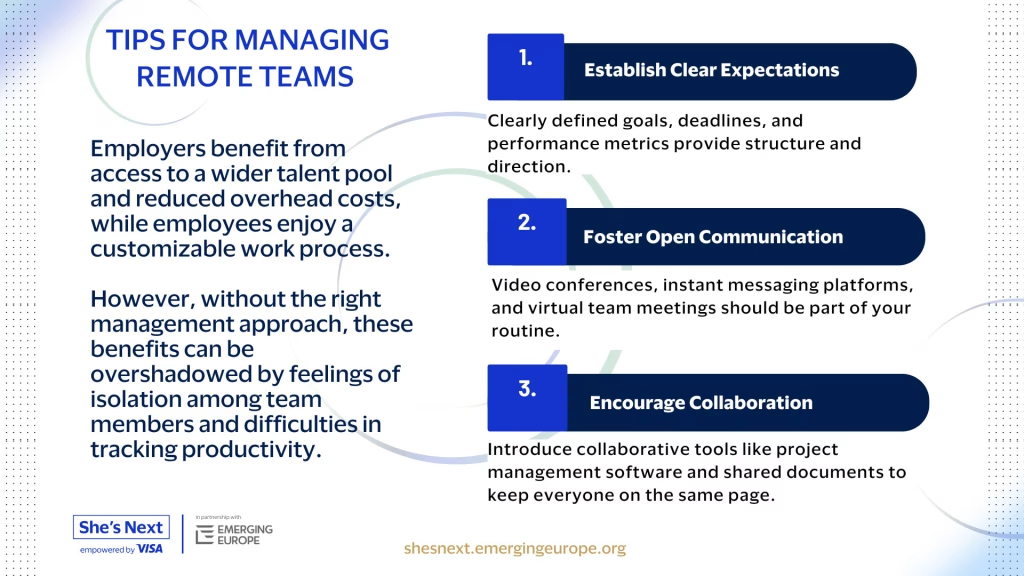
Remote Team Management
In recent years, the landscape of work has shifted dramatically, with remote work transitioning from a perk to a necessity for many businesses. This change is particularly significant for female entrepreneurs who often juggle multiple roles and may appreciate the flexibility that remote work offers.
However, managing a team that’s spread across various locations presents unique challenges. In this article, we’ll delve into effective strategies for managing remote or distributed teams, addressing communication hurdles, and ensuring that productivity thrives in a virtual work environment.
Understanding Remote Team Dynamics
Remote teams are inherently different from their in-office counterparts. They’re characterized by geographical dispersion, which can span cities, countries, and even continents. This diversity brings varying time zones and cultural backgrounds into play, enriching the team’s perspective but also complicating collaboration and communication.
For women in business, understanding and leveraging these dynamics can be both empowering and challenging. The flexibility of remote work can lead to better work-life balance, but it can also blur the lines between personal and professional life.
Employers benefit from access to a wider talent pool and reduced overhead costs, while employees enjoy the lack of commute and a customizable workspace. However, without the right management approach, these benefits can be overshadowed by feelings of isolation among team members and difficulties in tracking productivity.
Tips for Managing Remote Teams
Establish Clear Expectations
It is essential to articulate what you expect from your team. Clearly defined goals, deadlines, and performance metrics provide structure and direction. When expectations are transparent, team members understand their responsibilities and can manage their time effectively, which is especially important when they have the autonomy that comes with remote work.
Foster Open Communication
Regular communication channels are the lifeline of remote teams. Video conferences, instant messaging platforms, and virtual team meetings should be part of your routine.
As a leader, encourage an environment where transparency is the norm, active listening is practiced, and feedback flows freely in both directions. This open communication culture helps build trust and ensures that everyone feels heard and valued.
Encourage Collaboration
Collaboration doesn’t happen by accident in a virtual environment; it must be cultivated. Introduce collaborative tools like project management software and shared documents to keep everyone on the same page. Encourage brainstorming sessions and peer-to-peer interactions to foster a sense of teamwork and community.to keep everyone on the same page. Encourage brainstorming sessions and peer-to-peer interactions to foster a sense of teamwork and community.

Overcoming Communication Challenges
Addressing Communication Barriers
Misinterpretation of messages and the absence of non-verbal cues can lead to misunderstandings in a remote setting. Timezone differences might also delay responses, affecting the flow of work.
To mitigate these issues, establish clear communication norms, such as response time expectations and preferred channels for different types of communication. Regular check-ins and the use of visual aids during presentations can help clarify messages and ensure alignment.
Generational differences can significantly impact communication within a team or organisation, creating various barriers. These may stem from differences in technological preferences and proficiency, communication styles, resistance to change, and expectations regarding autonomy and collaboration.
For instance, older generations may prefer face-to-face communication, while younger generations might favour digital communication channels such as email or messaging apps. This disparity in communication styles can create misunderstandings and hinder effective collaboration.
To overcome these challenges, tailored communication strategies can be employed to accommodate the diverse preferences and styles of different generations. For example, using a mix of traditional and digital communication methods can ensure that all team members feel comfortable and engaged.
Intergenerational workshops offer a valuable platform for open dialogue and understanding between older and younger workers. Through these workshops, employees can share their perspectives, learn from each other’s experiences, and develop mutual respect and collaboration skills.
Moreover, mentorship programmes that pair employees from different generations can facilitate knowledge sharing and skill development. For instance, an experienced employee can mentor a younger colleague on industry-specific practices, while the younger employee can provide insights on the latest technological trends. This exchange of knowledge can enhance communication and teamwork, bridging the generation gap effectively.
Maintaining Productivity in a Virtual Work Environment
Setting Remote-Friendly Policies
Develop policies that support remote work without compromising productivity. Flexible work hours can accommodate different time zones and personal obligations, which is often crucial for women balancing business with family responsibilities.
Consider offering remote work stipends to help team members set up a comfortable and efficient home office. Shift focus from hours worked to tasks accomplished, using performance-based evaluations to measure success.
For female entrepreneurs leading the charge in today’s business world, mastering remote team management is key to success.
By implementing clear expectations, fostering open communication, encouraging collaboration, overcoming communication barriers, and setting remote-friendly policies, women-led businesses can thrive in a virtual work environment.
Embrace these strategies to optimize your team’s performance and maintain a productive, connected, and motivated workforce, no matter where they log in from.
New Free Courses — Made for Ambitious Women Entrepreneurs!
It’s time to grow smarter, adapt faster, and take your business global.
Explore two powerful courses available exclusively to She’s Next members:
The Reinvention Masterclass for Start-up Founders
Beyond Borders: Building for Global Success
Enroll today — it’s free!






Responses